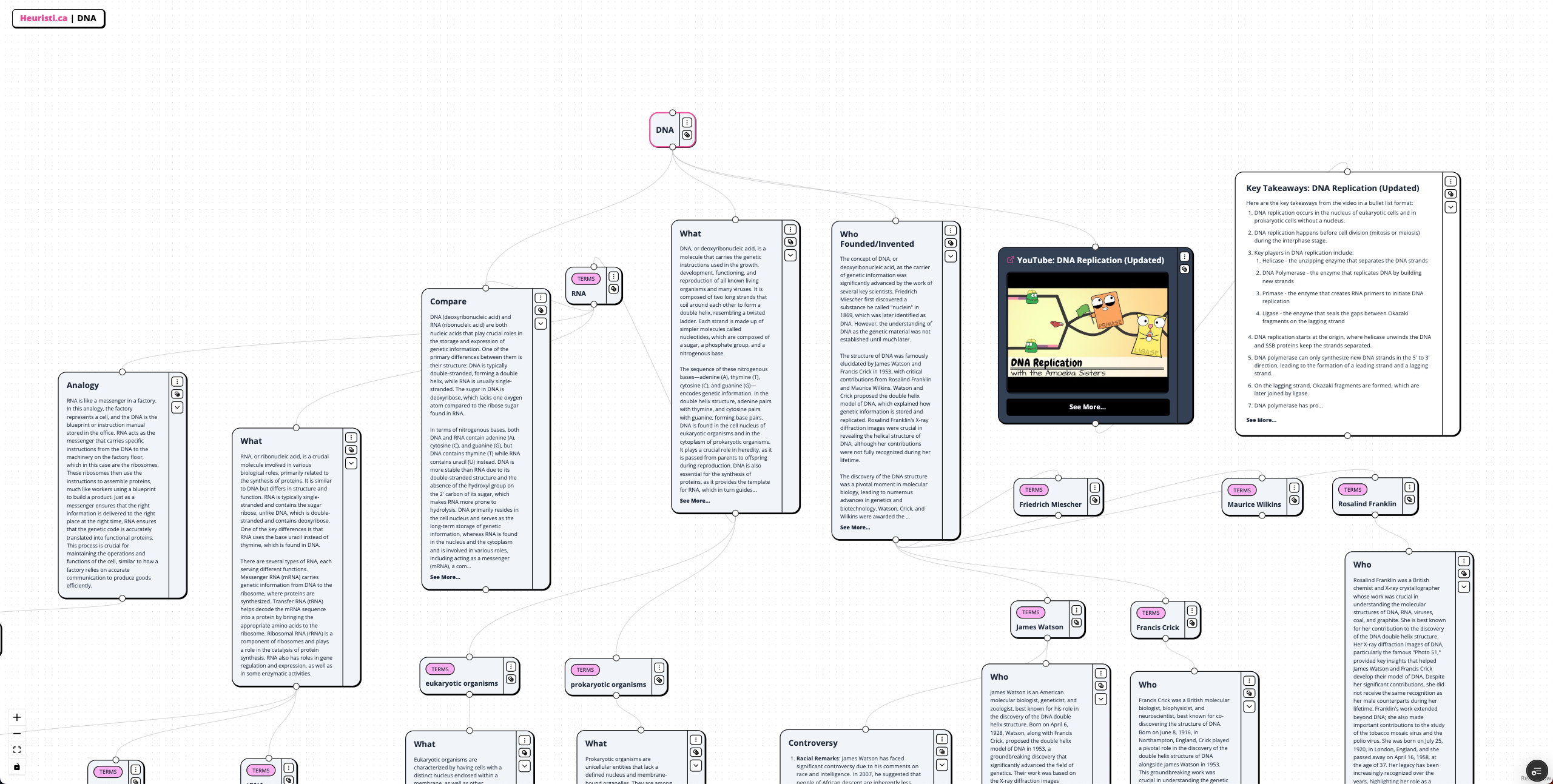DNA Concept Map

Summary
DNA, or deoxyribonucleic acid, is a molecule that carries the genetic instructions essential for the growth, development, functioning, and reproduction of all known living organisms and many viruses. It consists of two long strands that coil around each other to form a double helix, with each strand made up of nucleotides. The sequence of nitrogenous bases—adenine (A), thymine (T), cytosine (C), and guanine (G)—encodes genetic information. DNA is located in the cell nucleus of eukaryotic organisms and in the cytoplasm of prokaryotic organisms, playing a crucial role in heredity and protein synthesis.
The understanding of DNA as the genetic material was significantly advanced by scientists such as Friedrich Miescher, who discovered nuclein in 1869, and later by James Watson and Francis Crick, who elucidated the double helix structure in 1953, with contributions from Rosalind Franklin and Maurice Wilkins. Their work laid the foundation for modern molecular biology and earned them the Nobel Prize in 1962.
RNA, or ribonucleic acid, is a crucial molecule involved in various biological roles, primarily related to protein synthesis. Unlike DNA, RNA is typically single-stranded and contains ribose sugar. It plays several roles, including messenger RNA (mRNA), which carries genetic information from DNA to ribosomes; transfer RNA (tRNA), which helps decode mRNA into proteins; and ribosomal RNA (rRNA), which is a component of ribosomes.
The Human Genome Project (HGP), completed in 2003, has significantly influenced medical research by mapping the human genome and facilitating advancements in personalized medicine. It has enabled the identification of genetic mutations associated with diseases, leading to improved diagnostic tools and targeted therapies. The project also raised ethical, legal, and social issues regarding genetic information, prompting discussions about privacy, equity, and the commercialization of genetic research.
In summary, DNA and RNA are essential nucleic acids that play distinct yet complementary roles in the storage and expression of genetic information, with significant implications for biology, medicine, and ethics.
Key Takeaways
- It consists of two strands forming a double helix, made up of nucleotides containing a sugar, phosphate group, and nitrogenous base.
- The sequence of nitrogenous bases (A, T, C, G) encodes genetic information, with specific base pairing (A-T and C-G).
- DNA is located in the cell nucleus of eukaryotes and in the cytoplasm of prokaryotes.
- Friedrich Miescher discovered DNA in 1869, but its role as genetic material was established later.
- The double helix structure of DNA was elucidated by Watson and Crick in 1953, with contributions from Rosalind Franklin and Maurice Wilkins.
- Rosalind Franklin's X-ray diffraction images were crucial for understanding DNA's helical structure.
- The discovery of DNA's structure was pivotal for advances in molecular biology and genetics.
- The Human Genome Project mapped all human genes, significantly advancing genomics and personalized medicine.
- Prokaryotic organisms lack a defined nucleus and are simpler than eukaryotic organisms, which have membrane-bound organelles.
- RNA, or ribonucleic acid, plays a key role in protein synthesis and differs from DNA in structure and function.
- mRNA carries genetic information from DNA to ribosomes, tRNA translates this information into proteins, and rRNA is a component of ribosomes.
- The Human Genome Project raised ethical concerns regarding genetic information privacy and access.
- James Watson has faced controversy for his remarks on race and gender, despite his significant contributions to genetics.
- RNA is essential for translating genetic information into functional proteins, acting as a messenger in cellular processes.
- Ribosomes are the molecular machines that synthesize proteins by translating mRNA sequences into amino acids.
Additional Concepts
Questions and Answers
What is DNA?
Who discovered DNA?
What is the Human Genome Project?
What is the role of mRNA?
What are ribosomes?
What is the difference between DNA and RNA?
What is tRNA?
Flashcards
What is DNA and what role does it play in living organisms?
DNA, or deoxyribonucleic acid, is a molecule that carries the genetic instructions for the growth, development, functioning, and reproduction of all known living organisms and many viruses. It encodes genetic information through sequences of nitrogenous bases.
Who were the key scientists involved in the discovery of the DNA structure?
The structure of DNA was famously elucidated by James Watson and Francis Crick in 1953, with critical contributions from Rosalind Franklin and Maurice Wilkins.
What is the Human Genome Project?
The Human Genome Project (HGP) was an international scientific research initiative aimed at mapping and understanding all the genes of the human species, completed in 2003. It provided a comprehensive blueprint of human genetic information.
What are the main differences between DNA and RNA?
DNA is typically double-stranded and contains deoxyribose sugar, while RNA is usually single-stranded and contains ribose sugar. Additionally, RNA uses uracil instead of thymine, which is found in DNA.
What is the function of mRNA?
Messenger RNA (mRNA) carries genetic information from DNA to the ribosomes, where it is translated into a specific sequence of amino acids to form proteins.
What role does tRNA play in protein synthesis?
Transfer RNA (tRNA) translates the genetic code from mRNA into a specific sequence of amino acids by bringing the appropriate amino acids to the ribosome during protein synthesis.
What is the significance of Rosalind Franklin's work?
Rosalind Franklin was crucial in understanding the molecular structures of DNA through her X-ray diffraction images, which provided key insights that helped in the development of the DNA double helix model.
What are ribosomes and their function?
Ribosomes are complex molecular machines found in all living cells that synthesize proteins by translating the sequence of mRNA into amino acids.
What ethical concerns arose from the Human Genome Project?
The Human Genome Project raised ethical questions regarding privacy, potential misuse of genetic information, and concerns about genetic discrimination by employers and insurance companies.